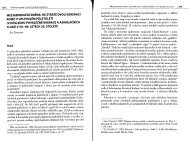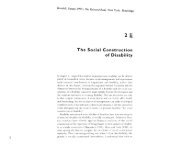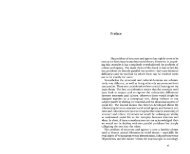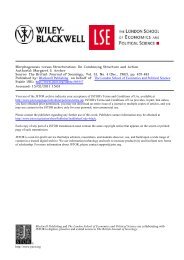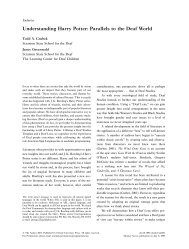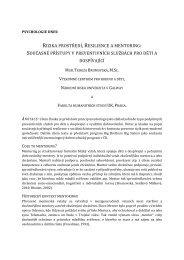Culture and Practical Reason Two Paradigms of ... - Moodle
Culture and Practical Reason Two Paradigms of ... - Moodle
Culture and Practical Reason Two Paradigms of ... - Moodle
- No tags were found...
You also want an ePaper? Increase the reach of your titles
YUMPU automatically turns print PDFs into web optimized ePapers that Google loves.
Chapter <strong>Two</strong> 120 <strong>Culture</strong> <strong>and</strong> <strong>Practical</strong> <strong>Reason</strong><strong>Two</strong> <strong>Paradigms</strong> <strong>of</strong> Anthropological Theory121meanings are constituted" (I973a, p. 31) tends to become a sociabilityfetishism, similar to the ecological by its substitution <strong>of</strong> abstract socialeffects for specific conceptual forms, the latter treated as mere appearances<strong>of</strong> the former, with the similar result <strong>of</strong>dissolving definite structural logicsinto inchoate functional interests.This is not to gainsay Douglas's fine sense for the human construction <strong>of</strong>experience. Still less is it to deny the critical importance <strong>of</strong> correspondencesset up in human societies between categories <strong>of</strong> persons <strong>and</strong>categories <strong>of</strong> things, or between the respective differentiations <strong>of</strong> thesetaxonomies. I mean only to suggest the limitations <strong>of</strong> an analysis that aimsto collapse the conceptual structure <strong>of</strong> an object code into a functionalmessage, as though cultural things were merely substantialized versions <strong>of</strong>social solidarities, the latter here assumed both as privileged <strong>and</strong> as practicalYSo in the end, the true logic <strong>of</strong> the social-cultural whole is utilitarian.Such is the result <strong>of</strong> adherence to the fateful Durkheimian separation <strong>of</strong>social morphology from collective representation.Levi-Strauss's refusal to grant that distinction ontological status, on theother h<strong>and</strong>-his appropriation <strong>of</strong> the social by the symbolic-was a decisivestep in the development <strong>of</strong> a cultural theory. 48 It is true that this didnot entirely disengage Levi-Strauss's work from functionalist concerns (cf.47. Another way <strong>of</strong> thinking about these limitations is to observe that Douglas is traffickingmainly in motivated relations between symbols, so that to define the meaning <strong>of</strong> one bythe logical connection to the other (the motivation) will necessarily pennit most <strong>of</strong> thecultural content to evaporate. Douglas is actually concerned with the functioning <strong>of</strong>already symbolic elements (affinal relationships, lineages, concepts <strong>of</strong> animals, foodtabus, etc.) as signs for one another-using "symbol" <strong>and</strong> "sign" now in the usualAnglo-American sense. (Indeed most anthropological studies addressed to the "symbolic"are similarly preoccupied with this second-order sign function rather than with theconstitution <strong>of</strong> symbolic fonn <strong>and</strong> meaning.) Yet as Rol<strong>and</strong> Barthes points out, animponant characteristic <strong>of</strong> the motivated sign (French, symbol), by contrast to the unmotivated,is that in the first there is no conceptual adequacy between signifier <strong>and</strong>signified: the concept "outruns" the physical sign, for example, as Christianity is greaterthan the cross (1970 [19641, p. 38). It is easy to see, then, that when both signifier <strong>and</strong>signified in a motivated sign relation are unmotivated symbols in their own right, thisinadequacy is doubly compounded. For given the logical relation between them, each <strong>of</strong>the elements, say food tabus <strong>and</strong> exclusive social groups, may act alternately as thesignifier or the signified <strong>of</strong> the other. Yet each remains, beside the sign <strong>of</strong> the other, asymbol in its own domain, whose concept also depends on differential relations withinthat domain. Consequently, one can hardly exhaust the meaning <strong>of</strong> either by the (fractional)analogy to the other. The semiotic analysis <strong>of</strong> food practices must far transcend thereference to social groups, as much as vice versa.48. "Uvi-Strauss seored because he did not look at cultural facts as somehow expressions <strong>of</strong>social forces; rather both were analyzed within a single frame <strong>of</strong> reference" (Kuper 1973,p. 223).Boon <strong>and</strong> Schneider 1974), but it did at least give such concern much lessroom to operate by precluding all simple reftectionism in the relationbetween society <strong>and</strong> ideology. It is also true that Levi-Strauss, in carryingthe Durkheimian enterprise to a consistent conclusion by including socialrelations within the general system <strong>of</strong> collective representations, arrives inthe process at a higher naturalism. One may even remark an apparentclosure <strong>of</strong> the theoretical circle: from Morgan's insistence that the growth<strong>of</strong> institutions was predetermined <strong>and</strong> limited by "the natural logic <strong>of</strong> thehuman mind" to a structuralist analysis whose coda is composed by asimilar phrase (Levi-Strauss 1971; 1972). But the course has been more aspiral than a circle, since all the appropriation <strong>of</strong> the symbolic intervenesen route; <strong>and</strong>, as we have seen, it would be an error to equate LeviStrauss's invocation <strong>of</strong> the mind with Morgan's "thinking principle,"which could do no more than react rationally to pragmatic values inherentin experience. "Never can man be said to be immediately confronted withnature in the way that vulgar materialism <strong>and</strong> empirical sensualism conceiveit," Levi-Strauss writes. His appeal to "/'esprit humain." then,would not short-circuit the symbolic, but rather would draw the consequences<strong>of</strong> its ubiquity. The argument proceeds on the simple premise that.inasmuch as the human world is symbolically constituted, any similaritiesin the operations by which different groups construct or transform theircultural design can be attributed to the way the mind itself is constructed.By the same premise, "similarities" here cannot intend the content <strong>of</strong> thatdesign, but only the mode <strong>of</strong> ordering. It is never a question <strong>of</strong> specificmeanings, which each group works out by its own lights, but the waymeanings are systematically related, which in such forms as "binary opposition"may be observed to be general. Nor, consequently, is it ever aquestion <strong>of</strong> "biological reductionism," a charge that a discussion <strong>of</strong> culturein the context <strong>of</strong> mind might otherwise invite. No particular customwill ever be accounted for by the nature <strong>of</strong> the human mind, for the doublereason that in its cultural particularity it st<strong>and</strong>s to mind as a difference doesto a constant <strong>and</strong> a practice to a matrix. The human nature to whichLevi-Strauss appeals consists not in an assemblage <strong>of</strong> substantial <strong>and</strong> fixedstructures, but in "the matrices from which structures belonging to thesame ensemble are engendered" (1971, p. 561).49 Thus the cultural ob-49. In this passage <strong>of</strong>L'Homme Nu. Levi-Strauss turns a phrase from Piaget-based, it seemsto me, on a structuralism deficient in cultural underst<strong>and</strong>ing (Piaget 1971 )-into a clearcritique <strong>of</strong> various biological reductionisms. Piaget had noted in effect that in realityevery fonn is a content relative to its encompassing fonn, as every content is a fonn <strong>of</strong> the



